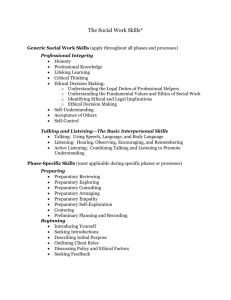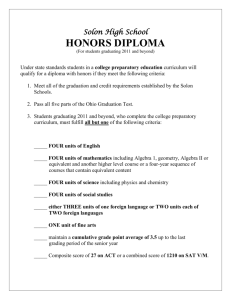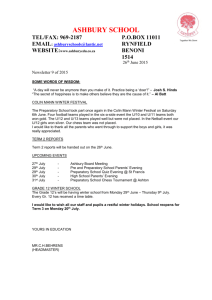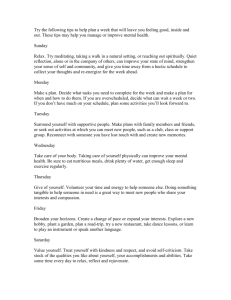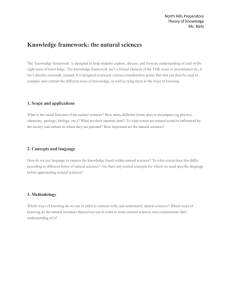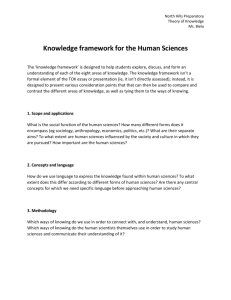304_Chapter5_Fall_2009 Revised for Mid Term
advertisement
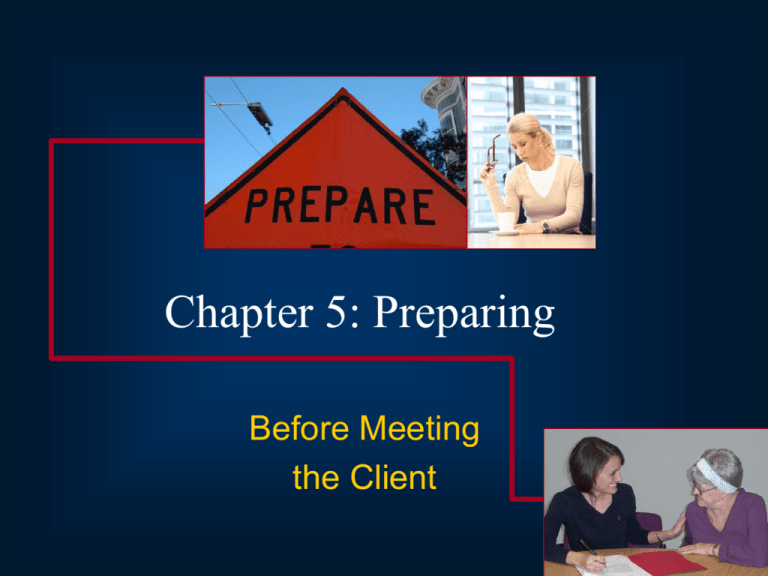
Chapter 5: Preparing Before Meeting the Client Before you meet the client…. Even before you meet your client there are a lot of things for you to consider. As you gain experience these steps will become more natural and you will be able to perform them quicker. Preparing To Meet Your Client This class covers the activities that you engage in prier to a meeting with a client. This information is particularly applicable to first interviews but also applies to subsequent meetings. Before we get started we will quickly take a look at the needs of the client as they come into our agencies for assistance. Prepare Client Needs Although it is difficult to put yourself in someone else’s position an effort must be made towards empathy with the client. Felix Biestek has identified seven needs of clients as they come into the helping situation. Remember... Preparing to meet the client is a good time to remind yourself of these needs. Keep them in mind as work progresses. What This Chapter Covers 1. 2. 3. 4. 5. 6. Preparatory Reviewing Preparatory Exploring Preparatory Consulting Preparatory Arranging Preparatory Empathy Preparatory SelfExploration 7. Preliminary Planning & Recording 8. Centering 9. Preparatory Exploring In Addition In addition to those topics we will also discuss the use of releases of information. We will also discuss techniques you can use to relax as an aide to helping you center and meet new clients. Preparing Preparing is the process of getting ready to meet the client in a fully professional manner. Preparing is a physical, spiritual and mental process. Preparatory Reviewing Preparing helps you to plan for contingencies – Such as the need for an interpreter, safety concerns, or other considerations It is: – Examination of different types of information available to you prior to contact. – Reviewing previous records or notes. Class Discussion Is it best practice to review old client records? Why or Why Not? Is it best practice to review old client records? Some very good practitioners are on both sides of this argument. In the end, you will need to make a considered decision based on your beliefs, the situation, and agency guidelines Class Exercise Divide into groups of three. Come up with two lists: 1. Positive reasons to review client records before meeting. 2. Negative reasons not to review those some records before meeting. Bane or Blessing? Negative Aspects of Reviewing Records Previous records could contain misinformation. Previous records could bias your judgement in a manner incongruent with the actual situation or client well-being. Positive Aspects of Preparatory Reviewing of Old Records Preparatory reviewing can prevent embarrassing, or even damaging, events. Preparatory reviewing shows respect and consideration for the client. – Many clients resent having to restate details they have already related Advice: Consider what has been said, or written, previously but make your own professional judgment. Previous records could contain errors, misinterpretations, or opinions that could have an undue negative bias. Preparatory Exploring Gathering the impressions that others have made Sources include: – Receptionist or other office personnel who may have had interaction – Referral sources Preparatory exploring gives you access to perspectives that might otherwise be lost. It involves asking questions about a prospective client and the situation Preparatory Reviewing with Referral Sources Whenever you receive a referral you will have some information about the client. That information could be very basic, or very complex. However, appropriate information from the referral source can be beneficial to facilitating work with the client. Releases of Information In most cases the flow of communication from the referral source and you, if it is more than just a referral for services, will require a release of information. What Is a Release of Information? Documentation that the client, or a legitimate person acting on behalf of the client, has given permission for the sharing of pertinent information: – In one direction (there needs to be a separate release for each direction of the flow of information) – For a limited scope and purpose. – For a limited period of time. The Direction of Information Flow As mentioned earlier there needs to be separate documentation for each flow of information. This slide explains. Release Documentation One Referring Agency Referral Agency Release Documentation Two Referring Agency Referral Agency The NASW Code of Ethics and Confidentiality Social workers should respect clients’ right to privacy. Social workers should not solicit private information from clients unless it is essential to providing services or conduction social work evaluation or research. Once private information is shared, standards of confidentiality apply. Social workers may disclose confidential information when appropriate with valid consent from a client or a person legally authorized to consent on behalf of a client. Social workers should protect confidentiality of all information obtained in the course of professional service, except for compelling professional reasons. The general expectation that social workers will keep information confidential does not apply when disclosure is necessary to prevent serious, foreseeable, and imminent harm to a client or other identifiable person or when laws or regulations require disclosure without a client’s consent. In all instances, social workers should disclose the least amount of confidential information necessary to achieve the desired purpose; only information that is directly relevant to the purpose for which the disclosure is made should be revealed. • NASW Code of Ethics, text pages 412-413 Sample Release of Information Form 1 Sample Release of Information Form 1 Sample Release of Information Form 2 Sample Release of Information Form 2 Sample Release of Information Form 3 Sample Release of Information Form 3 Preparatory Consulting Speaking with supervisors or colleagues about the client in a purposeful manner. Preparatory consulting is useful for clarifying – agency policies – legal factors – safety issues – technical issues relating to the client situation Sample Agency Policy Identify Potential Legal Issues Client and Your Personal Safety Matter Client Safety – Is client situation a safe or dangerous one? – Does the client have a history of dangerous behaviour? – Is the client at risk of self-harm? – Is the client at risk of harming others? Social Worker Safety – Are you at risk of being harmed? NASW and Protection of Social Worker Safety http://www.naswma.org/content.asp?contentID=143&topicID=28 Ethical Considerations: Seeking Advice and Consulting Social workers should seek the advice and counsel of colleagues when it is in the best interests of clients. Social workers should know colleagues’ expertise and competencies and seek consultation only from those who are knowledgeable, expert, and competent. When consulting about clients, disclose the least amount of information necessary to achieve the purposes of the consultation. – NASW Code of Ethics Class Exercise: Preparatory Consulting Discussion Take a few moments to read this example: – Brenda is an sixteen year old client with an IQ of 83 who has been referred for services to your agency. She is pregnant and claims that the father is a 32 year old uncle. She is currently taking psychotropic medications for a bi-polar disorder and another medication for seizures. She was recently arrested for shoplifting at a local convenience store. Break up into groups of three and discuss the areas, and issues, you might clarify with preparatory consulting relating to this client’s situation. Preparatory Arranging This is the logistical preparation for the meeting. It includes what has to happen for the meeting to take place as well as what needs to be arranged for the time to be spent effectively. It includes: – – – – scheduling the appointment adequate time & privacy organization of the physical environment your own physical state Do not ignore the actual setting where the meeting is to be held. Class Discussion Would you consider the interview settings below safe or unsafe? Why? Why not? Identify both safe and unsafe interview settings (place/location and layout of space)? Safety Considerations Do not ignore safety considerations when scheduling the interview, or when making other arrangements. The time, place and physical layout of the room needs to be considered whenever there are even modest concerns for safety. Putting oneself in the client’s shoes and trying to view the world through their eyes is…. …The heart and soul of EMPATHY Preparatory Empathy This is time spent before the client arrives anticipating their situation. This time should be spent considering the person-in-environment, as well as examining the situation from the strengths perspective. Preparatory empathy is a holistic exercise that should prepare you mentally for meeting the client on their terms. – – – – Who is the client? What is their experience like? Why are they coming here today? What will coming here be like for them? Empathy: Assessing Yourself Calculate your emotional quotient by completing the empathy quotient scale – http://glennrowe.net/BaronCohen/Empathy Quotient/EmpathyQuotient.aspx Empathy: Skill development resources Preparatory Self-Exploration Self-analysis of your personal reactions to them or their situation. Identification of potential effects of your – – – – – personal history characteristics needs, biases emotional buttons behavioral patterns. Preliminary Planning & Recording Tentative assessment of what the meeting is about and planning optimal outcomes for the client. What is the purpose of the visit (there could be more than one)? What are the possible outcomes? Why is the client coming and what are they wanting to take away? The Case of Brenda Refer back to the case of Brenda we discussed earlier. Imagine that you are at an agency that helps clients with Section 8 housing and that is why she is coming in today. Go over each area as you do your preliminary planning and recording: 1. Tentative assessment of what the meeting is about and planning optimal outcomes for the client. 2. What is the purpose of the visit (there could be more than one)? 3. What are the possible outcomes? 4. Why is the client coming and what are they wanting to take away? Centering Spiritually, physically, and mentally preparing for the meeting. Preparing to be with the client in the here and now. Attention and focus turning toward the client situation. The Goals of Centering Minimizing your own inner distractions. Preparing to maximize your potential of fully being with the client. Brief Centering Exercise While sitting in a chair, begin contracting / tightening your muscles from your neck down. First your neck, shoulders and chest. Hold for 15 seconds, then release. Next tighten your arm and back muscles. Hold and release. Next do the same with your stomach, back, arms, and legs, feet, hands, etc. etc. Brief Centering Exercise Lastly, contract your entire body – hold – release. Once you recognize the difference in your body between tension and relaxation, it will become easier for you to center. Tip : calm the body calm the mind calm the mind calm the body What can you do? Deep breathing Progressive relaxation Meditation Biofeedback Sound/music Self hypnosis Exercise and massage Diet and Nutrition Autogenic Training Deep breathing Consciously slowing heart rate, decreasing perspiration and relaxing muscles is more difficult than simply slowing and deepening breathing. Breathing can be used to directly stimulate the parasympathetic nervous system – results in relaxation and reverses changes from the stimulation of the sympathetic nervous system Chest vs. Abdominal breathing Put your right hand on your chest Put your left hand on your abdomen. As you breathe, see which hand rises more. If your right hand rises more, you are a chest breather. If your left hand rises more, you are an abdomen breather. Chest breathing is inefficient – results in less blood flow, less oxygen transfer to the blood and subsequent poor delivery of nutrients to the tissues. Abdominal breathing Place one hand on your chest and the other on your abdomen. Take a deep breath in, the hand on the abdomen should rise higher than the one on the chest. Exhale through the mouth, take a slow deep breath in through your nose and hold it for a count of 7 Slowly exhale through your mouth for a count of 8. Gently contract your abdominal muscles to completely push the remaining air from the lungs. Exhale twice as long as inhale Repeat 4 more times for a total of 5 deep breaths and try to breathe at a rate of one breath every 10 seconds (or 6 breaths per minute). To enhance, say to yourself the word, “relaxation” when inhale and “stress” when exhale – bring in the feeling/emotion you want with inhalation and release those you don't want with exhalation. Deepen respirations not by inhaling more air but through completely exhaling it. Other ways to center… Tension which has built up through out the day can lock up your upper body – shoulders, neck and head. When your neck and shoulder muscles are tight, you cannot optimally relax and be fully attentive to your clients. Practice the following simple relaxation techniques to help center yourself. Exercise 1 Exercise 2 Exercise 3 Progressive Relaxation Involves tensing specific muscle groups and then relaxing them to create awareness of tension and relaxation. It is termed progressive because it proceeds through all major muscle groups, relaxing them one at a time, and eventually leads to total muscle relaxation. Progress Relaxation Steps 1. Get comfortable. Lie down; loosen tight clothing, close your eyes and be quiet. 2. Focus on yourself and on relaxing specific muscles. 3. Tune out all other thoughts. 4. Tense and relax each muscle group 5. If any muscle remains tense, tighten and relax that specific muscle 3 or 4 times. 6. Repeat as needed 1. Forehead - Wrinkle your forehead, try to make your eyebrows touch your hairline for five seconds. Relax. 2. Eyes and nose - Close your eyes as tightly as you can for five seconds. Relax. 3. Lips, cheeks and jaw - Draw the centers of your mouth back and grimace for five seconds. Relax. Feel the warmth and calmness in your face. 4. Hands - Extend your arms in front of you. Clench your fists tightly for five seconds. Relax. Feel the warmth and calmness in your hands. 5. Forearms - Extend your arms out against an invisible wall and push forward with your hands for five seconds. Relax. 6. Upper arms - Bend your elbows. Tense your biceps for five seconds. Relax. Feel the tension leave your arms. 7. Shoulders - Shrug your shoulders up to your ears for five seconds. Relax. 8. Back - Arch your back off the floor for five seconds. Relax. Feel the anxiety and tension disappearing. 9. Stomach - Tighten your stomach muscles for five seconds. Relax. 10.Hips and buttocks - Tighten your hip and buttock muscles for five seconds. Relax. 11.Thighs - Tighten your thigh muscles by pressing your legs together as tightly as you can for five seconds. Relax. 12.Feet - Bend your ankles toward your body as far as you can for five seconds. Relax. 13.Toes - Curl your toes as tightly as you can for five seconds. Relax. What This Chapter Covered This chapter covered the activities that professional social workers engage in prior to client contact.


